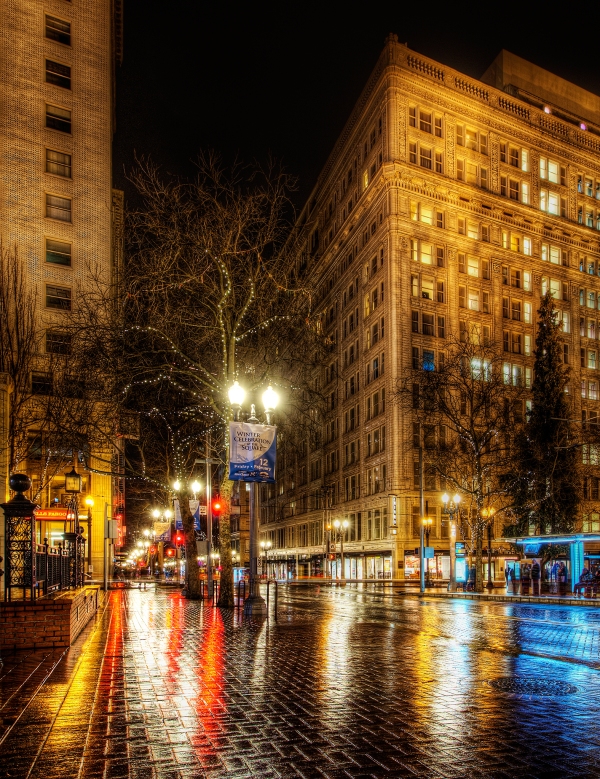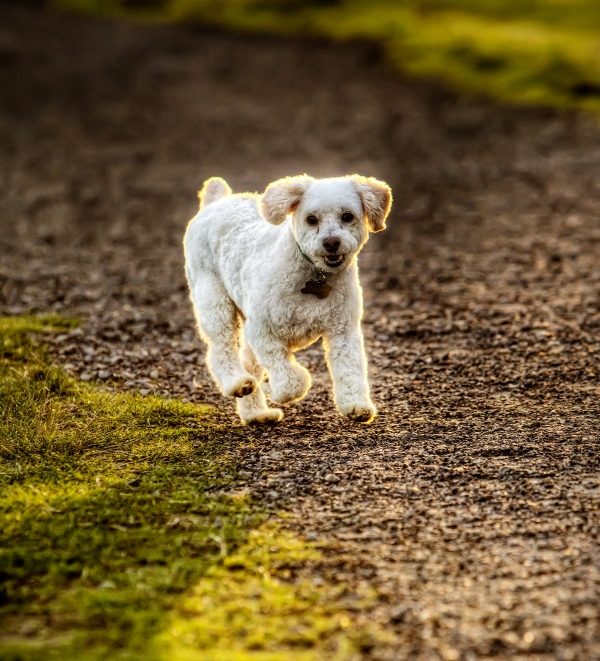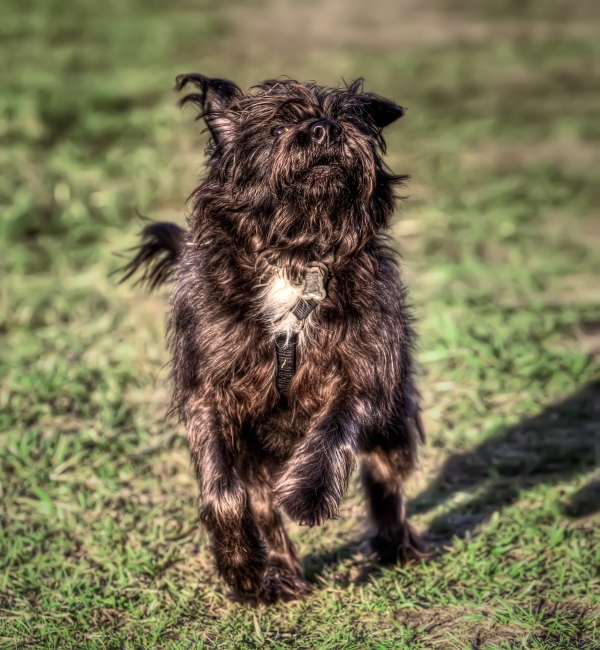Traditional Photograph vs. One Shot HDR
I processed some photos the last couple of days from pictures that I took at a dog park recently. I thought they turned out okay but then I decided to process either the same photo or a photo from the same burst again but using a “One Shot HDR” technique.
Basically, the original shots were either the same or very similar. For the one shot HDR’s I processed them at .5 EV steps from either -1.5 EV to +1.5 EV or from +1 EV to -1 EV using Photomatix. Then I brought them into CS4, applied adjustments, used Noiseware, and sharpened.
Below are the results (first – HDR; second – traditional).
One Way I Increase Contrast & Saturation in My HDR’s
I got a question from a viewer about how I increased saturation and contrast in my “Typical Portland” shot that I posted on Flicker.

My Flickr Comment:
“nrtphotos – First step is HDR through Photomatix. For this one I made two images – #1 was a pleasing HDR and #2 was #1 tone mapped again but with much different settings. I wanted a lot of texture in the buildings but most of the rest of #2 was garbage.
In the above photo (“Typical Portland”) I masked the sky with one of the original jpg’s to get it dark and smooth. I used pretty strong curve adjustments (strong S curves) to both #1 and #2 to increase contrast. Sometimes you have to go back and take away some of the highlights because it makes it to bright in spots. The trick is figuring out the best place to apply the anchor points. I usually look at the histogram on the curves and put my dark anchor point pretty close to the dark end and then put my light anchor point 1/3 of the way up.
I get it close and then I use the contrast slider to see if a little more would be helpful. The StuckInCustoms guy (Trey Ratcliff) mentions not being afraid of really having dark areas in your picture (and I mean really dark) because it helps anchor the photo. So I’ve started doing that in some of mine.
I didn’t use it for this photo but another trick I’ve picked up from comments on Flickr is using the selective saturation adjustment based on color. I sometimes crank each up and then mask only the parts that I want affected by the adjustment.
I did increase vibrance and then mask out parts that I didn’t like… for instance in this one it made the buildings to yellow… but I liked what it did to the street and the light reflections.
One last thing I should mention is that in this photo my camera’s AWB put a lot more yellow in the buildings and the photo than I remembered. So when I processing in Photomatix I cooled the temperature way donwn with the temp slider (I don’t usually do it but for this photo it really worked to add pop to the blue bus stop).
Check out my blog for a picture of my strong S curves and a peak at the rest of the adjustment panels.”
Hope this gives some insight.
Canon EOS 1D-Mark 4 Mini Review – Coming Soon
This past 4-5 days I’ve used my Mark 4 nearly daily.
Tests:
1) I took some 7 shot AEB exposures in a rainy and wet downtown (Portland, Oregon) to make some cool new HDR’s.
2) I gave the autofocus a bit of a workout using the 70-200 f/2.8 lens on my black lab as she ran towards me with her tennis ball.
3) I took some engagement photos for friends over two evenings using a 580EX flash and a CP-E4 flash battery pack.
Mini Results:
1) HDR – Bracketed series look good – excited to try some HDR.
2) The autofocus and AI Servo tracking was great (I updated the firmware before testing). Used the auto ISO setting and pegged the lower bound for the aperture at f/5.6. It produced really clean head shots that were consistently in focus. I’m really excited and confident in its ability.
3) The engagement photos look great. The AEB and spot metering setting really nailed the color. So happy. With my 5D Mark II the colors never seemed quite this good out of the camera. One thing to note that was really annoying was that I had limited in camera control over the flash. The 580EXII, 430EX II, 270EX all allow full control but not the 580EX. Hmmmm… I made due but was not happy to find that out (p. 121 of the Mark 4D instruction manual).
I plan to post some of the photos and give a more in-depth overview of the above in the coming week or two. If you’d like to see these in any specific order let me know.
Acapella and HDR
I think HDR Photography is a great art form. There are so many.
I was in Tacoma, WA this past weekend and stopped by the Museum of Glass. Since I had my dog with me, I didn’t get to go into the museum but instead took some photographs of the unique architecture.
As I was processing the picture above, I decided to listen to some music of an artist, Del Soul, that I had come across about a week ago.
At first glance an acapella artist might seem out of place on an HDR blog but in a lot of ways this artist does with sound what HDR photographers do with light
I wanted to share his amazing talent with you. I encourage you to listen to each one of his videos. He has done a fantastic job.
Here’s a link to his version of Fireflies by Owl City. It’s my favorite.
Seattle Sunset – 7 Shot Hand – Held HDR
I was in Seattle the last couple of days visiting some good friends, catching up, explaining the basics of photography, camera functions, and even a little Photoshop.
The weather was great and there was even a great sunrise and sunset. However, this weekend was not about capturing the perfect Seattle shot. It was about sharing the joys of photography with friends.
I had a great time and it was relaxing, too.
The shot below was taken at Golden Garden Park in Seattle, WA at sunset. I asked my subjects not to move and they both did a great job.
7 Shots Hand Held
ISO 640
-5 EV to +5 EV
1/2000s – .5s
f/14
Canon 1D Mark 4 vs. Nikon 3Ds
Came across a review here from neutralday.com between the Canon and Nikon flagships.
It’s worth a read especially if you are interested in a new high end camera. It looks as if the images are even cleaner from the Nikon 3Ds than the Canon 1D Mark 4… And the dance continues…
Canon 1D Mark 4 – Hand Held HDR – ISO 3200 – Mini Review
The Canon 1D Mark 4 is amazing. Canon has finally combined a phenomenal sensor with firmware that makes shooting an HDR under even the widest dynamic range possible with just one click. You are able to bracket up to 7 shots choosing (either in 1/3 or 1/2 steps) a range of 1/3 EV to 3 EV between each of the 7 shots. That’s confusing but it is as good as it sounds.
For example:
.5 EV increments: [-1.5, -1, -.5, 0, +.5, +1 +1.5]
1 EV increments: [-3, -2, -1, 0, +1, +2, +3]
1.3 EV increments: [-4, -2.67, -1.34, 0, +1.34, +2.67, +4]
1.5 EV increments: [-4.5, -3, -1.5, 0, +1.5, +3, +4.5]
3 EV increments: [-9, -6, -3, 0, +3, +6, +9]
The image below was shot hand held at ISO 3200. I used my terrible apartment lighting without any other light source (ie. flash). I used a small LED flashlight to reflect against my calibration target to increase the dynamic range of the scene. It should be pointed out that Zoey did not move throughout the entire series of shots. She was tired and is very used to having her picture taken.
The photograph above was created from a 7 shot series with the settings below:
ISO 3200
f/4
EV -1.33 steps from [-4 to +4]
.6 s – 1/160 s
24-105 L IS On
Hand Held
Manual White Balance
I processed the 7 RAW files in ACR to TIFFs and brought those into Photomatix using Trey Ratcliff’s (Stuck in Customs) processing method to create a tone mapped TIFF (he uses JPGs). I cleaned up the image in Photoshop CS4 using curves for contrast and vibrance to desaturate Zoey’s black coat and only masked a little of the blanket in the foreground from a slightly different tonemapped TIFF. I then applied Noiseware Professional and sharpened Zoey’s face with unsharp mask.
NOTE: I converted the TIFFs to JPG’s and saved them at their max size along with the final HDR file. All files can be viewed and/or downloaded here.
I see endless possibilities for low light hand held HDR.
I plan to update this blog periodically with reviews, HDR tips, tricks, and photographs. Check back periodically for updates.








